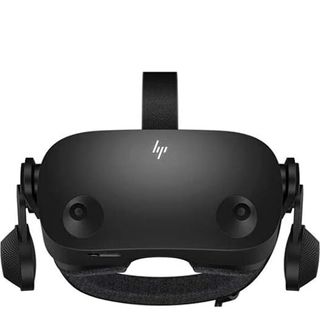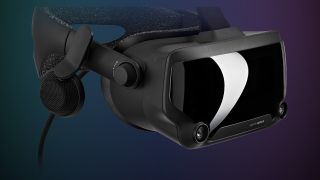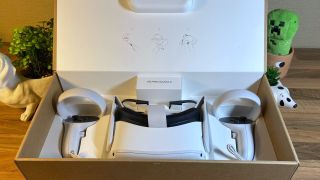Best VR headset for Microsoft Flight Simulator in 2024
Take to the skies with Microsoft Flight Simulator VR and the best headset for the job.

• The list in brief ↴
1. Best overall
2. Best for PC
3. Best budget
4. Best for visuals
• How to choose
Since its initial release in 2020, Microsoft Flight Simulator has changed its naming scheme for the upcoming 2024 release, but the core gameplay remains the same. Virtual reality (VR) headset support was added soon after launch and is expected to remain for future updates.
Flying real-world aircraft in a 3D recreation of the entire planet Earth is a breathtaking experience anyway, but virtually inserting yourself into a cockpit with the best VR headset is on another level of immersion.
Officially, Microsoft supports a range of VR headsets from PC-centric brands like Valve and HP. However, standalone options from Meta work perfectly thanks to their integration with PC VR, making Flight Simulator more accessible than ever. Here are my top picks for the best overall VR headset and alternatives for your Flight Sim needs.

A PC gamer at heart, I've always been an enthusiast for immersive gameplay. Playing simulators in virtual reality sold me on the experience from my first try, and I'm eager to get more people involved with the scene.
The quick list

Best overall
While it's primarily advertised as a mixed-reality headset, the Quest 3 is by far the best value and most versatile VR option available today, with a comfortable and lightweight build. Works perfectly with desktop PCs or laptops via a companion app.

Best for PC
There aren't many brands more knowledgeable about the PC gaming space than Valve, and its Index headset is perfect for anyone sticking to PC-only gaming in VR. It requires base stations, but controller tracking is accurate and reliable.

Best budget
Although the Quest 3 is available, it hasn't necessarily replaced the Quest 2, which still offers an ultra-affordable entry point into VR and works with desktop PCs or gaming laptops. Choose this if you're a newcomer or are otherwise unsure about VR.
Load the next headset..

Best for visuals
Developed with the help of Microsoft and Valve, the G2 offers 2160 x 2160p resolution for each eye and compatibility with Windows Mixed Reality alongside general PC gaming with SteamVR. For the highest visual fidelity, go with HP.
The best VR headset for Microsoft Flight Simulator in 2024
Why you can trust Windows Central
Choosing the best VR headset for Microsoft Flight Simulator will depend on a few factors, primarily your budget. Thankfully, virtual reality is far from a brand-new niche with inflated prices in 2024, so your options are far more flexible than ever. Here are my detailed picks in each category.
The best overall VR headset for Microsoft Flight Simulator

1. Meta Quest 3
Specifications
Reasons to buy
Reasons to avoid
My personal choice for VR gameplay in Microsoft Flight Simulator, and it's no surprise to see Meta rise to the top thanks to its unparalleled efforts in the virtual reality hardware and software scene. A versatile headset with more to offer than just PC VR gaming, you get full-color mixed reality with passthrough cameras for cable-free play powered by the headset or to help you get comfortably set up in your simulation rig and see exactly where your flight stick, pedals, and more are positioned.
Our friends at Android Central named it "the best VR headset you can buy" in its Meta Quest 3 review, and I'm in complete agreement. Not only is it compatible with PC VR through a USB-C cable or wirelessly over Air Link with a reliable Wi-Fi 6 router or better, but it's also comfortable to wear, and the lenses have never been better. It's more expensive than its predecessor but has become the most accessible and best overall VR headset for many audiences, including simulation enthusiasts diving into the likes of Euro Truck Simulator 2 and Microsoft Flight Simulator.
You get a 2064 x 2208 resolution per eye with a 110-degree field of view (FOV) and an adjustable 58 - 71 mm interpupillary distance (IPD) range handled by a physical wheel and a digital readout. This all amounts to a customizable and high-quality viewing experience that shouldn't strain your eyes after a few hours of play. My IPD sits around 66 mm, and it's a much better solution than the three-notch adjustment found on the Quest 2. There's really nothing better for an across-the-board solution to playing Microsoft Flight Simulator in virtual reality than the Meta Quest 3.
The best PC VR headset for Microsoft Flight Simulator

2. Valve Index VR headset kit
Specifications
Reasons to buy
Reasons to avoid
Valve's Index system is currently the pinnacle of VR. It might not have the same visual fidelity as the HP Reverb G2 — check out our Valve Index vs. HP Reverb G2 article for more info — and it might not offer as much freedom as the Oculus Quest 2. However, the combination of precision tracking, a comfortable headset, and seamless Steam integration makes it a coveted item.
It has dual 3.5-inch LCD displays with a combined resolution of 2880x1600, which is around 1600x1440 per eye. The field of view is a wide 130 degrees, and the refresh rate can hit up to 144Hz. These are some beefy specs achieved with the help of the best desktop PCs for VR.
The Index has a manual interpupillary distance (IPD) adjustment slider as well as adjustable eye relief, both in an attempt to cater to as many people as possible. The headset's harness has multiple adjustable points so that you can get a comfy fit, and there is high-quality built-in audio. Two base stations handle precision tracking, and the Index motion controllers are the best available. Of course, you might want to check out the best joysticks and flight sticks for Flight Simulator instead.
The Index is available as a complete package for about $1,000, but you can also piece out the purchase if you have existing Vive hardware. This is an expensive way to go, but it's going to ultimately deliver the most thorough VR experience inside and outside of Flight Simulator.
The best budget VR headset for Microsoft Flight Simulator

3. Oculus Quest 2 VR headset
Specifications
Reasons to buy
Reasons to avoid
The Oculus Quest 2 — known as the Meta Quest 2 after Facebook decided to change its name — set itself apart from the other VR headsets in this collection with the ability to operate without a PC. It packs a Snapdragon XR2 processor, 6GB of RAM, and up to 256GB of storage right inside the head-mounted display (HMD). At the front is an LCD display with 1832x1920 resolution per eye, and a built-in battery lasts about two or three hours before needing a charge. You can find out more thanks to our pals at Android Central and their Oculus/Meta Quest 2 review.
Since we're focusing on Flight Simulator, you'll want to add Oculus Link to the package. It's a specialized USB-C cable that allows you to tether the Quest 2 to your PC, essentially turning it into an Oculus Rift. You'll get access to Oculus and Steam game libraries, as well as full compatibility with the VR side of Flight Sim. Our collection of the best Quest 2 Link cable alternatives can help save you money if you don't mind skipping the official Oculus offering.
The Quest 2 came with updated Oculus Touch motion controllers that rely on inside-out tracking from the headset. They're comfortable and provide touch-capacitive sensors for a realistic feel. There are a few downsides to the Quest 2. You need a Facebook account to use it, and there's a limit to the IPD adjustment. However, if you want an untethered experience that can double up as a VR system for Flight Simulator, this is the way to go.
The best VR headset for visuals in Microsoft Flight Simulator

4. HP Reverb G2 VR headset
Specifications
Reasons to buy
Reasons to avoid
Whereas the Valve Index is a complete package with external tracking and the best motion controllers around, the HP Reverb G2 focused heavily on the headset experience. If you're sitting at a desk with your hands on the best yoke for Microsoft Flight Simulator, this might be all that matters.
The Reverb G2 has dual 2.89-inch LCDs, each with a resolution of 2160x2160. That's a combined 4320x2160 resolution, which completely blows the Index away. IPD adjustments are manual, allowing you to get a great viewing experience.
HP updated its Reverb G2 in late 2021, adding a new face gasket for eye relief adjustments and broader FOV, as well as better controller tracking. The "G2-V2" (as many were calling it) also received a new cable with an updated link box and better compatibility with AMD systems. The native FOV is a bit narrower than the Index at around 90 degrees and the refresh rate tops out at 90Hz; still, these specs require a powerful PC to achieve.
Valve helped HP design the Reverb G2, so the harness and audio system are familiar to Index users. You're going to get great sound from the built-in headphones, and the straps are adjustable for extra comfort. There's no light bleed around the face gasket, and there's plenty of padding.
The drawback to the Reverb G2 is its motion controllers. They're not nearly as intuitive as the Index controllers, and they rely on inside-out tracking from the headset. As mentioned, though, you might not be using the controllers much if you're focusing on Flight Simulator. If you just want the best visuals to experience the world from the air, this is the way to go.
How to choose the best VR headset for Microsoft Flight Simulator
Microsoft Flight Simulator is truly a futuristic gaming experience, made only better with a VR headset. Instead of staring into a monitor, you can inject yourself into a pilot's chair and take a good look around while you fly across the world. Adding VR to Flight Simulator takes an already PC-intensive game and ramps things up. If you need an upgrade, be sure to check out the best pre-built gaming PCs for Flight Simulator as well as the best gaming laptops for Flight Simulator.
If you already have a gaming PC but haven't given it any love in a few years, something from our collection of the best graphics cards can add some much-needed power. Stock shortages can still cause issues, but you might get lucky and find something that's not being scalped for an obscene price.
Any of the above VR headsets will do a great job of wowing you within the game, but the Valve Index is the best full system available for various games. Visuals, audio, controls, and tracking all come together to create something special, and it will be a literal game-changer for all PC activities. If you want the absolute best, this is it.
However, if you're focusing exclusively on Flight Simulator and don't care as much about external tracking and motion controllers, the Meta Quest 3 makes it the best overall choice. It delivers the best balance of visual fidelity and pricing that I've ever seen and will turn the streamed world of Flight Simulator into a proper treat.
Get the Windows Central Newsletter
All the latest news, reviews, and guides for Windows and Xbox diehards.

Ben is the channel editor for all things tech-related at Windows Central. That includes PCs, the components inside, and any accessory you can connect to a Windows desktop or Xbox console. Not restricted to one platform, he also has a keen interest in Valve's Steam Deck handheld and the Linux-based operating system inside. Fueling this career with coffee since 2021, you can usually find him behind one screen or another. Find him on Mastodon @trzomb@mastodon.online to ask questions or share opinions.
- Cale HuntContributor
